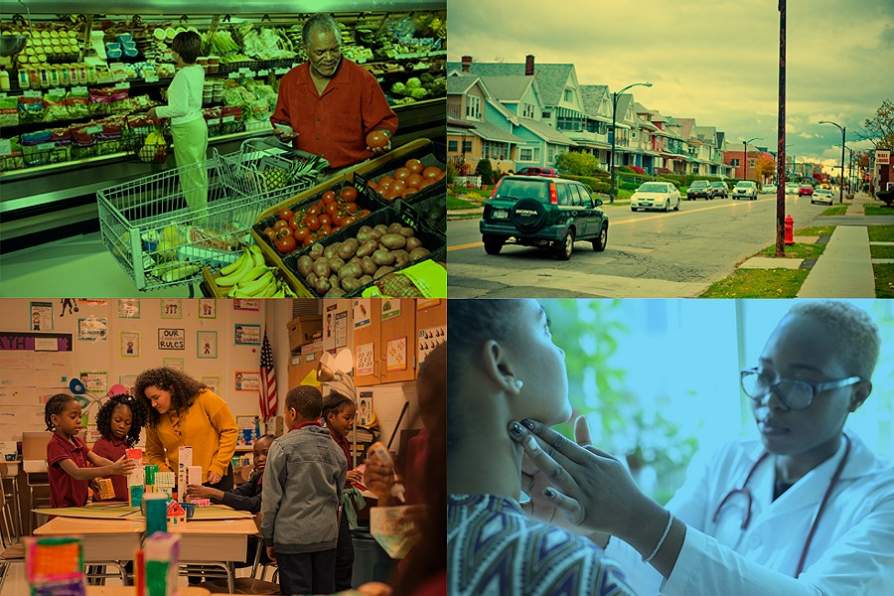Reversing health inequities in Buffalo – New UB website a go-to resource for researchers and community groups
University at Buffalo took a major step toward addressing health disparities in Buffalo’s African American community and developing innovative solutions to eliminate them when it established its Community Health Equity Research Institute in 2019. Now the institute has launched a website, for use by community groups and partners, to give them a voice in the impactful community research being conducted at UB.
“The goal of the institute is to transform the way that UB researchers conduct research,” said Tim Murphy, MD, director of the institute and SUNY Distinguished Professor in the Jacobs School of Medicine and Biomedical Sciences. “We want our researchers to take a participatory community approach, to bring community groups into the conversation to guide the direction of research from the very beginning instead of formulating an idea and then connecting with the community. For example, if a community partner needs the expertise of the university for a project, it can request help through the website, and the institute can connect the group with a faculty collaborator who has the right expertise. The site will also help researchers utilize community-based methods, such as holding focus groups to understand community perspectives and leverage that input for the best community outcomes.”
The site provides researchers with the resources they need to conduct meaningful scholarly work driven by community interests and priorities. The institute’s nine local partners include the Buffalo Center for Health Equity, the Population Health Collaborative and LISC (Local Initiatives Support Corporation) Western New York, among other influential organizations. A key emphasis will be on multidisciplinary research throughout the university because direct interventions in the health care system result in only marginal improvements. Major changes in addressing health inequities for African Americans in WNY will require research into innovative solutions that grapple with a wide range of issues, including gentrification, the physical environment, food deserts, transportation issues, criminal justice, housing, education, and employment. To foster the institute’s multidisciplinary goals, all 11 of UB’s schools, plus the College of Arts and Sciences, are institute partners, noted Leah Daniel, institute administrator.
“We want to engage our university researchers as broadly as possible,” Murphy added. “We want to attract talented people doing innovative work to begin to address the health inequities in our community.”
Services that can be requested through the website by UB faculty, students or staff, or by members of community groups include assistance in identifying potential collaborators, community partners, specific populations in the community and appropriate, targeted funding opportunities. Murphy, who is also director of the Clinical and Translational Science Institute (CTSI), says, “UB has made a huge university commitment to this, supported by the highest levels of the administration. We are committed to working with, and for, our community.”
He explained that the website will function as a community resource, a “go-to” site that brings together all the groups in the community who are already doing great things. “Members of the community are welcome on this site,” explained Daniel, “so they will have an opportunity to see what the institute is doing. It will function as a community resource.” That community-facing orientation goes back to the CTSI’s roots, Murphy said. He noted that the $15 million National Institutes of Health grant to UB and its partners back in 2015 was the catalyst that eventually resulted in the Community Health Equity Research Institute.
“The CTSI partnered with community groups right from the time it was formed,” he said. “That partnership was a spark that got us all talking to each other, and the Community Health Equity Research Institute is building on that.” In particular, the institute emerged out of collaborations between the CTSI and the drivers behind the African American Health Equity Task Force, notably George F. Nicholas, pastor of Lincoln Memorial United Methodist Church and convener of the task force; Kinzer Pointer, pastor of Liberty Missionary Baptist Church and task force co-convener; and Rita Hubbard Robinson, a community leader and CEO of Neuwater & Associates LLC and an associate director of the institute. The institute was established in 2019 to address health inequities that primarily affect African Americans living in specific ZIP codes on the East Side of Buffalo, where Black residents die prematurely at a much higher rate than white people; experience higher rates of poverty, lung cancer and infant mortality; and are at increased risk of being hospitalized for chronic diseases like heart failure and diabetes. Those inequities became even more evident in early 2020, when communities of color nationally and locally began to be devastated by the COVID-19 pandemic.
“The partnership between the task force and the Community Health Equity Research Institute was instrumental in partially mitigating the deadly impact of the pandemic in communities of color in Buffalo,” said Murphy.
The vision of the website was guided chiefly by contributions from three members of the institute’s Steering Committee: Henry Taylor, PhD, professor of urban and regional planning, School of Architecture and Planning, and associate director of the institute; Kelly Wofford, community engagement coordinator in UB’s Center for Nursing Research in the School of Nursing; and Christopher St. Vil, PhD, assistant professor in the School of Social Work.
Staff members who were instrumental in the design and creation of the website are Joseph Ventresca, IT business analyst, CTSI; Christopher Schobert, CTSI communications director; Leah Daniel, institute administrator; and Sandy Post, executive assistant to Murphy.











